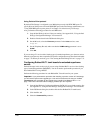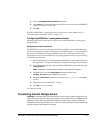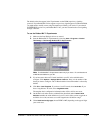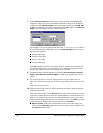
CHAPTER 7. INSTALLING INTEL DIALOGIC BOARD DRIVERS 7-33
4. Select the HostIpMediaNetworkAddress parameter.
5. In the
Value field, enter the IP address of the NIC that you want to use for RTP/RTCP
traffic (for example, “192.168.1.6”.)
6. Click
OK.
If you have DI/SI32 Rev 1 analog station boards, go to the next section. Otherwise, go to
“Test-starting the Intel Dialogic drivers” on page 7-33.
Configuring DI/SI32 Rev 1 analog station boards
Perform the steps in this section only if you have one or more DI/SI32 Rev 1 analog station
boards installed.
Assigning the a-law firmware file
The DI/SI32 Rev 1 board is not detected automatically by DCM as are the other DM3 boards,
so you are not prompted to assign it a firmware file as described on page 7-14. Also, the DI/SI32
Rev 1 board is automatically assigned the DISI32.pcd (u-law version) firmware file. If you
require the a-law version of the firmware file in your geographical location, assign it according
to the following instructions.
1. Start the Intel Dialogic Configuration Manager (DCM) if it is not already running. See
See Appendix D, “Using the Intel Dialogic Configuration Manager” for instructions.
2. In the DCM main dialog box, right click the first DI/SI32 Rev 1 board and then select
Configure Board.
Note:
DI/SI32 Rev 1 boards are label “DISI32” in the DCM main dialog box.
3. On the Misc tab, select the PCDFileName parameter and then select
@DISI32_ALaw.pcd from the Value drop-down list.
4. Select the
FCDFileName parameter and then type @
DISI32_ALaw.fcd
in the Value
text box.
5. Repeat for your other DI/SI32 Rev 1 boards.
6. Click
OK to save your changes.
Go to the next section.
Test-starting the Intel Dialogic drivers
Important: Verifying that the correct audio format (a-law or u-law) has been configured on your
system will help ensure good audio quality. Using the wrong audio format can contribute to other
problems and make them more difficult to troubleshoot. Under certain conditions, DCM may
automatically set your audio format to a-law. Take a moment to verify that the correct audio format
has been selected, and change it if necessary.


















